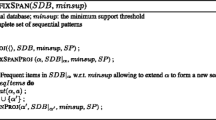Abstract
Sequential pattern mining (SPM) under gap constraint is a challenging task. Many efficient specialized methods have been developed but they are all suffering from a lack of genericity. The Constraint Programming (CP) approaches are not so effective because of the size of their encodings. In [7], we have proposed the global constraint Prefix-Projection for SPM which remedies to this drawback. However, this global constraint cannot be directly extended to support gap constraint. In this paper, we propose the global constraint GAP-SEQ enabling to handle SPM with or without gap constraint. GAP-SEQ relies on the principle of right pattern extensions. Experiments show that our approach clearly outperforms both CP approaches and the state-of-the-art cSpade method on large datasets.
Access this chapter
Tax calculation will be finalised at checkout
Purchases are for personal use only
Similar content being viewed by others
Notes
- 1.
A wildcard is a special symbol that matches any item of \(\mathcal {I}\) including itself.
- 2.
A sequential pattern p is maximal if there is no sequential pattern q such that \(p \preceq q\).
- 3.
We indifferently denote \(\sigma \) by \({{\langle d_1, \dots , d_j \rangle }}\) or by \({{\langle \sigma (P_1), \dots , \sigma (P_{j}) \rangle }}\).
- 4.
- 5.
- 6.
- 7.
References
Agrawal, R., Srikant, R.: Mining sequential patterns. In: Yu, P.S., Chen, A.L.P. (eds.) ICDE, pp. 3–14. IEEE Computer Society (1995)
Ayres, J., Flannick, J., Gehrke, J., Yiu, T.: Sequential pattern mining using a bitmap representation. In: KDD 2002, pp. 429–435. ACM (2002)
Béchet, N., Cellier, P., Charnois, T., Crémilleux, B.: Sequential pattern mining to discover relations between genes and rare diseases. In: CBMS (2012)
Coquery, E., Jabbour, S., Saïs, L., Salhi, Y.: A SAT-based approach for discovering frequent, closed and maximal patterns in a sequence. In: ECAI, pp. 258–263 (2012)
Fournier-Viger, P., Gomariz, A., Gueniche, T., Soltani, A., Wu, C., Tseng, V.: SPMF: a Java open-source pattern mining library. J. Mach. Learn. Res. 15, 3389–3393 (2014). http://jmlr.org/papers/v15/fournierviger14a.html
Ji, X., Bailey, J., Dong, G.: Mining minimal distinguishing subsequence patterns with gap constraints. In: ICDM 2005, pp. 194–201 (2005)
Kemmar, A., Loudni, S., Lebbah, Y., Boizumault, P., Charnois, T.: PREFIX-PROJECTION global constraint for sequential pattern mining. In: Pesant, G. (ed.) CP 2015. LNCS, vol. 9255, pp. 226–243. Springer, Heidelberg (2015)
Kemmar, A., Ugarte, W., Loudni, S., Charnois, T., Lebbah, Y., Boizumault, P., Crémilleux, B.: Mining relevant sequence patterns with CP-based framework. In: ICTAI, pp. 552–559 (2014)
Li, C., Wang, J.: Efficiently mining closed subsequences with gap constraints. In: Proceedings of the 2008 SIAM International Conference on Data Mining, pp. 313–322 (2008)
Li, C., Yang, Q., Wang, J., Li, M.: Efficient mining of gap-constrained subsequences and its various applications. Trans. Knowl. Discov. Data 6(1), 2:1–2:39 (2012)
Métivier, J.P., Loudni, S., Charnois, T.: A constraint programming approach for mining sequential patterns in a sequence database. In: ECML/PKDD Workshop on Languages for Data Mining and Machine Learning (2013)
Negrevergne, B., Guns, T.: Constraint-based sequence mining using constraint programming. In: Michel, L. (ed.) CPAIOR 2015. LNCS, vol. 9075, pp. 288–305. Springer, Heidelberg (2015)
Pei, J., Han, J., Mortazavi-Asl, B., Pinto, H., Chen, Q., Dayal, U., Hsu, M.: PrefixSpan: Mining sequential patterns by prefix-projected growth. In: ICDE, pp. 215–224. IEEE Computer Society (2001)
Pei, J., Han, J., Wang, W.: Mining sequential patterns with constraints in large databases. In: CIKM 2002, pp. 18–25. ACM (2002)
Wu, X., Zhu, X., He, Y., Arslan, A.N.: PMBC: pattern mining from biological sequences with wildcard constraints. Comput. Biol. Med. 43(5), 481–492 (2013)
Yang, G.: Computational aspects of mining maximal frequent patterns. Theoret. Comput. Sci. 362(1–3), 63–85 (2006)
Zaki, M.J.: Sequence mining in categorical domains: incorporating constraints. In: CIKM 2000, pp. 422–429 (2000)
Zaki, M.J.: SPADE: an efficient algorithm for mining frequent sequences. Mach. Learn. 42(1/2), 31–60 (2001)
Zhang, M., Kao, B., Cheung, D.W., Yip, K.Y.: Mining periodic patterns with gap requirement from sequences. TKDD 1(2) (2007)
Author information
Authors and Affiliations
Corresponding author
Editor information
Editors and Affiliations
Rights and permissions
Copyright information
© 2016 Springer International Publishing Switzerland
About this paper
Cite this paper
Kemmar, A., Loudni, S., Lebbah, Y., Boizumault, P., Charnois, T. (2016). A Global Constraint for Mining Sequential Patterns with GAP Constraint. In: Quimper, CG. (eds) Integration of AI and OR Techniques in Constraint Programming. CPAIOR 2016. Lecture Notes in Computer Science(), vol 9676. Springer, Cham. https://doi.org/10.1007/978-3-319-33954-2_15
Download citation
DOI: https://doi.org/10.1007/978-3-319-33954-2_15
Published:
Publisher Name: Springer, Cham
Print ISBN: 978-3-319-33953-5
Online ISBN: 978-3-319-33954-2
eBook Packages: Computer ScienceComputer Science (R0)




